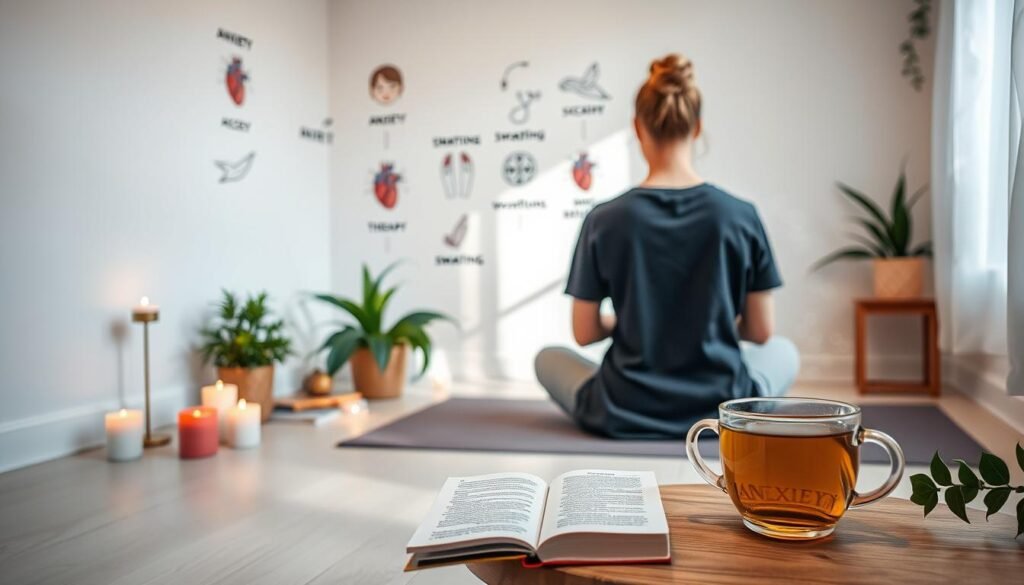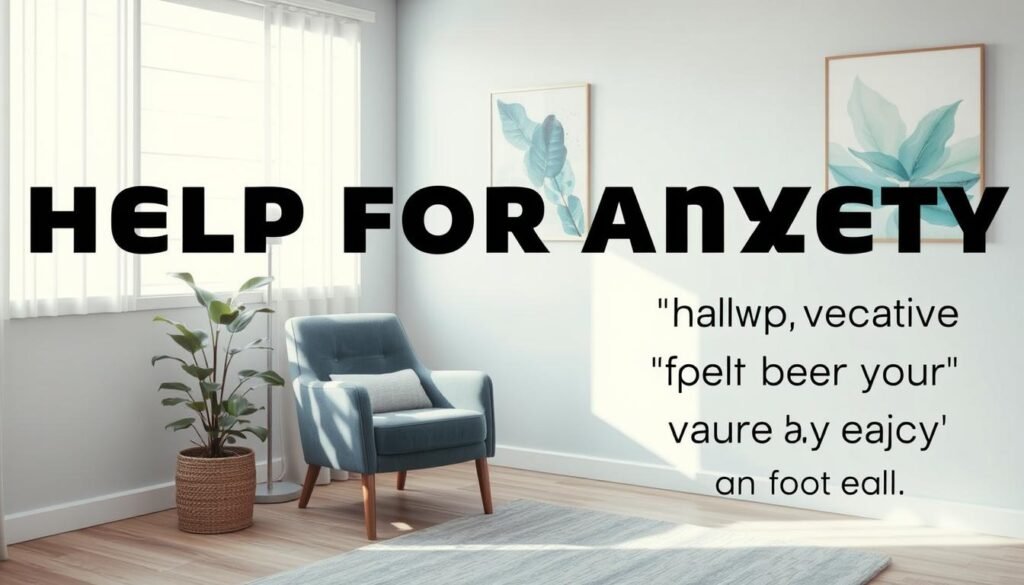Did you know over 40 million adults in the U.S. face anxiety disorders? This fact shows how important it is to know the difference between fear and anxiety. These feelings often happen together but come from different places and affect us in unique ways. Fear is a natural response to real danger, making us act quickly. Anxiety comes from worrying about what might happen, without a clear reason. This section will help you understand these feelings better. That way, we can learn more about their effect on mental health.
Key Takeaways
- Understanding fear is crucial for effective personal responses to immediate threats.
- Anxiety often stems from anticipated dangers rather than immediate threats.
- Behavioral and physiological responses differ significantly between fear and anxiety.
- The study of emotions encompasses both biological and cognitive perspectives.
- Pathological anxiety can hinder an individual’s ability to cope with life challenges.
- Recognizing triggers can aid in differentiating between fear and anxiety.
- Understanding these emotions improves approaches to managing anxiety disorders.
Understanding Fear
Fear helps protect us by making us react quickly to dangers. Knowing what causes fear is key to dealing with it well.
What Triggers Fear?
Fear comes from real dangers. Some common things that scare people are:
- Loud noises
- Unfamiliar situations
- Threats of harm
These things can make our bodies react strongly. You might notice your heart beats faster, you breathe quicker, and you’re more alert. This gets you ready to either run away or face the danger.
The Biological Response to Fear
This reaction is the “fight or flight” response. It’s a natural part of how we survive. When we’re scared, our bodies release stress hormones. This leads to:
- Accelerated heart rate
- Surge in adrenaline
- Enhanced awareness of surroundings
These changes help us deal with dangers right away. For people who often feel scared, understanding this can help tell fear apart from anxiety. Fear is usually about something that’s happening now, while anxiety might not be.
Defining Anxiety
Anxiety is a complex emotion that is different from fear. It includes constant feelings of worry or nervousness. It can be caused by many anxiety triggers, often found in daily life. These include work stress, issues in personal relationships, and money problems. Knowing what triggers anxiety helps us understand why some people get very anxious in certain situations.
Common Triggers of Anxiety
It’s important to know what triggers anxiety to manage it well. Common triggers include:
- Work-related stress and concerns about performance
- Worries about money and financial stability
- Conflicts in relationships or family pressures
- Concerns about health and medical issues
About 20% of adults in the U.S. face anxiety disorder symptoms yearly. Women report it more than men. Knowing these triggers can help individuals fight anxiety better.
The Emotional Response to Anxiety
The way we react to anxiety is often complicated. Symptoms can be feeling restless or getting irritable. They can also include physical signs like a fast heartbeat. Sleep-related anxiety is important too. It can make sleeping hard, causing tiredness and more anxiety.
Understanding how anxiety affects people helps us see its impact better:
| Symptoms | Description |
|---|---|
| Restlessness | Feeling unable to stay calm or still, sometimes with a sense of excitement or energy. |
| Racing Heartbeat | An elevated heart rate that can cause worry and feelings of panic. |
| Sleep Disturbances | Having trouble sleeping because of anxious thoughts or discomfort. |
| Panic Attacks | Sudden, extreme fear with symptoms like heart pounding and chest pain. |
Understanding the emotional response to anxiety helps find better ways to cope. There are many treatment options. These range from cognitive-behavioral therapy (CBT) to practicing mindfulness. All these methods aim to address both the causes of anxiety and how we feel because of it.
Fear vs Anxiety: Key Differences
Knowing how fear and anxiety differ is key for our mental health and handling stress. Fear comes from real, immediate risks, making us react fast to danger. Anxiety, however, is about worries for the future and lasts longer. We will look at the fear vs anxiety differences related to the nature of threats, how long we feel them, and our body’s reactions.
Real vs Imagined Threats
Fear is our response to actual, immediate dangers. It helps us survive. Think of meeting a wild animal or being in a risky situation. Anxiety deals with worries over things that might not happen, causing a general feeling of worry when there’s no real danger. Unlike the instant reaction fear triggers, anxiety makes us fret over possible dangers ahead.
Duration and Persistence of Emotions
Fear’s intense emotions don’t last long. They fade once the danger is gone. But anxiety sticks around, making us constantly worry about future “what ifs.” This worry cycle can greatly affect our everyday lives and how we feel overall.
Physical Symptoms Comparison
Fear and anxiety both bring physical signs. Fear speeds up our heart rate, raises blood pressure, and sharpens our senses for quick action. Anxiety leads to a wider range of symptoms like dizziness, nausea, and ongoing muscle tension because it lasts longer. Recognizing these signs helps us understand our feelings and react in the best way.
| Aspect | Fear | Anxiety |
|---|---|---|
| Nature of Threat | Real and immediate | Imagined or anticipated |
| Duration | Short-term | Long-term |
| Primary Symptoms | Increased heart rate, dilated pupils | Dizziness, muscle tension, worry |
The Connection Between Fear and Anxiety
Understanding the link between fear and anxiety is key. Fear can trigger anxiety, starting a self-feeding cycle. Often, a fear response leads to worry without any real danger. This cycle of fear leading to anxiety comes from how our brains handle past scary events.
How Fear Can Lead to Anxiety
When people feel fear, their bodies react to protect them. This reaction may turn into anxiety for some. As fear makes us very alert, the brain might see situations as threats that are not truly dangerous. This mistaken belief can cause ongoing anxiety, making everyday life hard. How we form and recall memories when scared plays a big role in this process.
The Role of Past Experiences and Memory
Past experiences influencing anxiety are major in how we react to new stress. Even small fears from childhood can change how memories and anxiety work together. Research shows that those with anxiety are more sensitive to old threats. These memories affect how we feel now, leading to anxiety over similar new situations. This shows how memory and anxiety are linked, highlighting the importance of treating these patterns.
Recognizing the Signs of Fear
Knowing how fear shows up is key to handling our feelings better. People show signs of fear in their actions and bodies, depending on how scared they are. Spotting these signs helps us deal with fear in a healthier way and makes us stronger emotionally.
Immediate Physical Reactions
Our bodies respond to fear very quickly. We might notice:
- Increased heart rate
- Sweating
- Muscle tension
- Shivering or trembling
- Dilation of pupils
These happen because of adrenaline and cortisol, hormones that get us ready to either fight or run. Understanding these signs helps us recognize when we’re afraid.
Behavioral Responses to Fear
How we act can also show we’re scared. We might:
- Flee from a threatening situation
- Freeze in place, unable to move
- Put up emotional walls
- Stay away from others
These actions can be healthy, like avoiding real danger, or unhealthy, affecting our daily lives. Knowing the difference helps us respond to fear better.
Understanding Anxiety Disorders
Anxiety disorders are conditions that deeply affect daily life. They hit nearly 30% of adults at some time. These disorders have various symptoms that can mess up daily routines. Knowing the common symptoms helps recognize when to get help.
Common Symptoms of Anxiety Disorders
People with anxiety disorders can face many symptoms. These often include:
- Excessive worrying: Constant concerns about everyday events.
- Panic attacks: Sudden, intense fear with physical symptoms.
- Social anxiety: Fear of judgment or being watched by others.
- Phobias: Strong fear of certain things or situations, leading to avoidance.
- Difficulty concentrating: Struggling to focus because of anxiety.
Generalized anxiety disorder (GAD) involves ongoing anxiety for months. Panic disorder may bring many panic attacks a year. Social anxiety disorder and phobias cause one to avoid many situations. This affects work and personal life a lot.
When to Seek Help for Anxiety
Knowing when to get help for anxiety is key. Signs you might need help include:
- Impact on daily functioning: Anxiety that messes up your social, work, or personal life.
- Duration of symptoms: Feeling anxious for weeks or months.
- Physical health concerns: When anxiety hurts your health.

Cognitive behavioral therapy (CBT) works well for anxiety disorder symptoms. Medicines like antidepressants or anti-anxiety drugs also help. Seeking help can improve life. It helps manage anxiety symptoms better over time.
Investigating the Physical Symptoms
Looking into the physical signs of anxiety means exploring how fear and anxiety are similar. Both can cause a big stress reaction in the body, leading to similar symptoms. Knowing these patterns helps in understanding and tackling anxiety better.
Similarities in Physiological Responses
Fear and anxiety lead to the same kind of body reactions. Some common ones are:
- Increased heart rate
- Shortness of breath
- Muscle tension
This shows how our bodies respond to stress. Knowing this can help us find the right help, like therapy or medicine, when it’s needed.
Responses to Stressful Situations
Stressful events make our bodies react in specific ways. This may include:
- Shaking or trembling
- Rapid breathing
- Gastrointestinal issues
Understanding these reactions helps see how anxiety shows up in the body. For deeper understanding, the American Psychiatric Association offers more info. It’s crucial for finding ways to deal with anxiety effectively.
Managing Fear Effectively
Managing fear is key for better emotional health. There are many ways to deal with fear. By facing fears instead of avoiding them, people can feel much better.
Strategies for Coping with Fear
It’s important to use practical steps to handle fear. Here are some strategies to try:
- Keep a Fear Journal: Write down emotions and what causes them for a few weeks. This helps find patterns and decide on the best ways to cope.
- Practice Mindfulness: Being mindful helps stay calm and aware, reducing fear-related anxiety.
- Gradual Exposure: Slowly facing what scares you can make your brain less sensitive to it. This method can help lessen fear over time.
- Deep Breathing Techniques: Deep breaths can calm anxiety attacks quickly, helping in stressful times.
- Seek Professional Help: Talking to therapists who know about CBT or ACT can improve your ability to manage fear.
- Regular Physical Activity: Exercising can lower anxiety levels, leading to a healthier mind and body.
Benefits of Facing Fears
Confronting fears has many benefits. It builds emotional strength and confidence. This makes future challenges easier to handle. Key advantages include:
- Gaining self-esteem by overcoming fears.
- Being better at handling stress in life.
- Feeling less isolated, which creates a stronger bond with others.
- Understanding and addressing fears boosts overall well-being.
Using the right strategies against fear makes it a tool for growth. Help is out there for anyone struggling with anxiety and fear, like the tips in this article.

| Coping Strategies | Benefits |
|---|---|
| Journaling | Identifies fear patterns |
| Mindfulness | Enhances awareness |
| Gradual Exposure | Desensitizes fear responses |
| Deep Breathing | Provides immediate relief |
| Professional Help | Offers tailored strategies |
| Physical Activity | Reduces anxiety symptoms |
Coping Strategies for Anxiety
Anxiety can affect daily life, including your sleep and emotional state. It’s important to handle these challenges. Techniques that help you relax can make sleep better. They can also help with anxiety at night.
Relaxation Techniques for Sleep
Using relaxation techniques can make your sleeping area peaceful. There are many methods you can try, like:
- Deep Breathing: It soothes your nerves and lowers your heart rate. It’s a great way to relax.
- Progressive Muscle Relaxation: Tightening and then relaxing your muscles eases stress-caused tension.
- Meditation: Mindfulness meditation focuses your thoughts and brings calm, making sleep easier.
Building a Calming Bedtime Routine
A calming routine at bedtime helps manage anxiety. It gives your evening structure, which brings comfort. Here are some good strategies:
- Consistent Sleep Schedule: Sleeping and waking up at the same times every day tunes your body’s clock.
- Limit Screen Time: Avoiding screens before bed leads to better sleep.
- Relaxing Activities: Calm activities like reading or stretching help you unwind before bed.
Using these anxiety coping strategies along with sleep relaxation techniques helps. It’s key to a calming bedtime routine. Staying dedicated to these methods boosts mental health. They help cut down anxiety and better your sleep.
Seeking Professional Help
If you often feel anxious and it’s impacting your day-to-day life, getting professional help is crucial. There are many treatment options for anxiety disorders available. These options help people manage their anxiety better. Learning about these treatments can greatly improve the lives of those dealing with anxiety.
Therapeutic Approaches to Treatment
Cognitive Behavioral Therapy (CBT) is a top method for anxiety disorders. It usually takes 12-14 sessions. CBT teaches people to recognize and change negative thoughts and actions. This change helps improve how they feel. Qualified Psychologists, skilled in CBT, have a high success rate in reducing symptoms of anxiety.
Exposure therapy is another strong approach. It gently exposes people to what scares them in a safe way. This helps them handle their fear and stop avoiding scary situations. Dialectical Behavior Therapy (DBT) combines mindfulness with CBT techniques. It helps people become more aware of what triggers their anxiety.
Various Treatment Options Available
Those with anxiety disorders have a lot of treatment options for anxiety disorders to choose from. These include medication and therapy. Drugs like SSRIs can help ease the symptoms for people with Generalized Anxiety Disorder (GAD) or panic disorder. Talking about these options is vital, especially when feelings of harm or suicidal thoughts are present. Immediate help from a professional is then needed.
Acceptance and Commitment Therapy (ACT) is a different kind of therapy. It teaches acceptance of things we can’t change. It also encourages people to change their behavior where they can. This is especially helpful for dealing with big fears or phobias. Additional help can come from community resources and learning materials. For example, advice on helping someone with anxiety can support both the person and their helpers.

Conclusion
Knowing the difference between fear and anxiety is key for managing emotions well. Fear is a direct response to a threat right now. Anxiety is more about worrying over what might happen later.
There are good ways to handle both fear and anxiety. Methods like therapy and digital tools help a lot. Knowing how your body reacts to these feelings can help you control your mental health and grow stronger.
Understanding fear and anxiety helps us handle them better. It also lets us learn more about ourselves. For deeper insights, check out this informative article. Learning about these emotions helps us find better ways to cope and improve our emotional health.